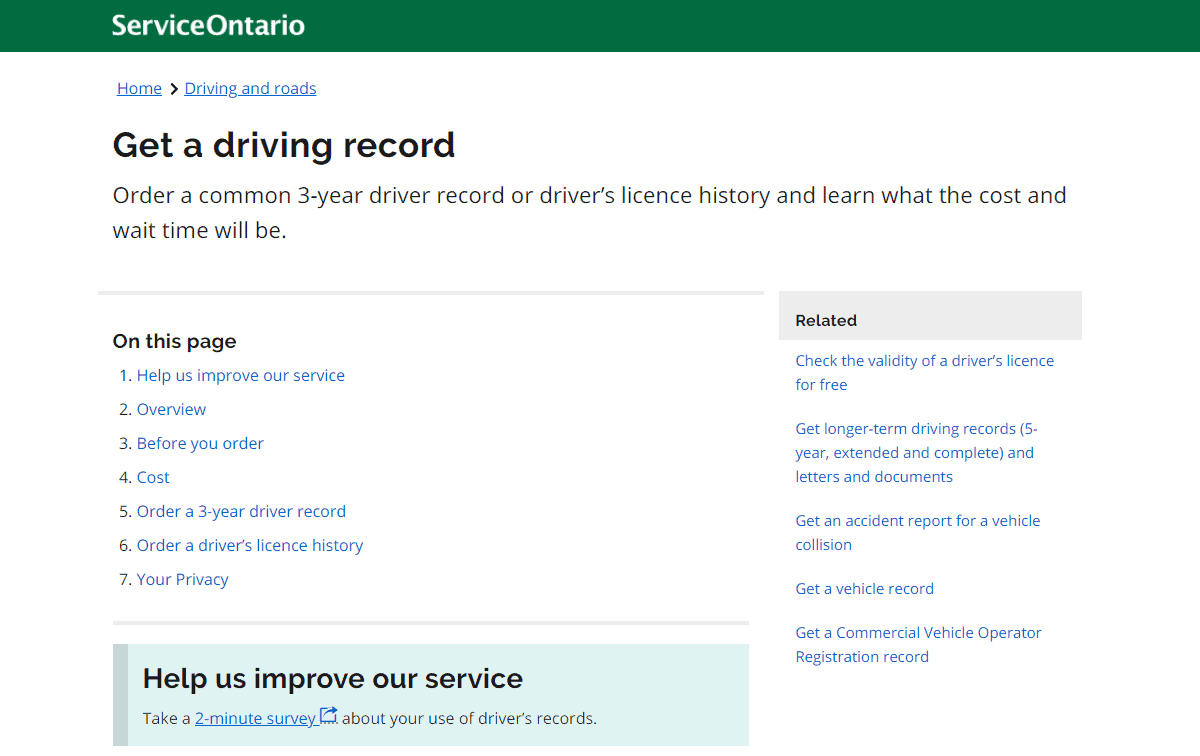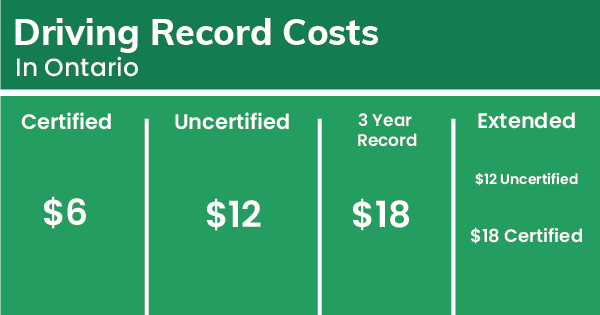If you have an Ontario drivers license, then you have an Ontario drivers record. In fact, you’ll have an MTO drivers abstract and Ontario record for your entire life.
The recording of your driving activity begins from the day you start to drive until you retire from the road. However, most drivers have never seen their driving records. Accordingly, they don’t know what it looks like or what it includes.
In Ontario, your driving abstract is an important document. It outlines your driving history. If you’re shopping for insurance, it’s always a good idea to review your drivers abstract to better understand how insurers will assess your premiums.
To learn more about Ontario drivers abstracts, keep reading.
What Is the Difference Between A Driving Record and an Ontario Drivers Abstract?
If you need an Ontario drivers abstract, you may have quite a few questions. It helps to understand the difference between your driving record in your drivers abstract. Your driving record is an account of your activities as a licensed driver in Ontario.
You may have a G1, G2 or G drivers license. If so, there’s a record of your driving history.
However, a drivers abstract is one of several kinds of records of your driving history. You can obtain your drivers abstracts from the Ontario Minister of Transportation (MTO). Most often, people are referring to a three-year uncertified driver record when they mention a drivers abstract.
What Kind of Information Is on A Drivers Abstract?
There are a few critical pieces of information in an Ontario driver abstract. For instance, it will include your:
• Name
• Date of birth
• Sex
• Height
• Current address
• Drivers license number
• Date licensed
A drivers abstract will also include your classification. For example, it will consist of whether you hold a G1, G2, G or other driving classification.
It will also list any driving restrictions. For example, it might list a medical limitation, such as requiring you to wear glasses when driving.
The abstract will also list your status. It will state whether your current license is valid or invalid.
Furthermore, your abstract will list any driving convictions. It will also list any traffic tickets or pending convictions. Also, your drivers abstract will list any demerit points.
The three-year abstract, for example, will provide this information for the stated time. However, an extended drivers abstract can show your driving information for up to five years.
How Long Do These Things Stay On Your Driving Record?
Even after you’ve paid your tickets, you may still face the consequences of past driving infractions. For example, you might experience the consequences of a past infraction when you want to purchase or renew a car insurance policy.
If you maintain a clean driving record, you’ll get rewarded when insurers calculate your insurance premium. If you have a minor accident, however, you might see a minimal increase in your premium. If you have multiple infractions on your drivers abstract, you could see a significant increase in your car insurance payment.
An infraction such as a speeding violation might remain in your abstract for three years. Meanwhile, a demerit may stay on your record for two years, but they don’t directly impact your insurance rates.
Why or When Would I Need One?
There are several instances where you may want your drivers abstract. Some people may need a driver abstract to move to a new province. Again, you may want to purchase or renew your car insurance.
When you buy or renew insurance, the insurer will review your drivers abstract. The information in your drivers abstract is one of many pieces of data that insurers use to assess your premium. If you purchase new insurance, for example, the new underwriter may also request a claims experience letter from your current insurer.
You might also want to review your drivers abstract if you’re applying for a job. Your abstract is especially important if you’re applying for a job that requires driving.
For instance, you may want a job in sales, trucking, delivery services or you may want to operate a taxi or ride share. In these instances, a drivers abstract is usually an important part of the application process.
Yet other drivers want to check their abstract out of curiosity. Also, some people want to know when a ticket or infraction is scheduled to fall off their driving abstract. Removing infractions quickly can help to lower your insurance costs.
Where Can I Get My Driving Record in Ontario?
There are several ways that you can get your driving abstract in Ontario. You can obtain your abstract by following a few simple steps.
You’ll want to start by determining what type of record you need. Next, you’ll visit the Service Ontario website
There, you can find information to order your drivers abstract in person. Alternatively, you can order your abstract online or through the mail. In either case, you’ll need to pay for your drivers abstract—more on that in a moment.
The easiest way to get your drivers abstract is to order it online. You’ll need your driver’s license number when ordering your abstract through Service Ontario. After placing your order, you’ll receive your certified drivers abstract in the mail.
You can also access your drivers abstract by visiting a Service Ontario kiosk. Finally, you can call Service Ontario at (900) 565-6555 and ask them to send your abstract in the mail.
How Much Does It Cost?
Many people believe that they should have the ability to access their drivers information for free. Nevertheless, you’ll need to pay a nominal administrative fee to retrieve your driving record.
The fee for retrieving your record varies depending on the information that you request. Also, you’ll typically pay a bit more for a certified abstract.
You can order a certified or uncertified license check for free. However, the MTO charges a nominal fee for a confirmation letter or drivers documents.
It costs $6 to purchase an uncertified version of these records. The certified versions will cost $12.
An uncertified three-year abstract will cost you $12. Meanwhile, you’ll pay $18 for a certified three-year driving abstract.
The MTO charges the same for the following five products—your collision report, license history, three-year report, five-year report and extended record. You’ll pay $12 for an uncertified copy of these records. Meanwhile, you’ll pay $18 for a certified copy of the same information.
What Is a CVOR?
CVOR stands for Commercial Vehicle Operators Registration. The CVOR oversees commercial carrier safety to make the highways safer for everyone.
It’s a drivers permit for commercial purposes. For instance, you’ll need a CVOR certificate if you operate a tow truck.
If you own a commercial vehicle, your CVOR abstract will highlight your commercial carrier information. Unlike a drivers license, however, a CVOR is attached to a vehicle. For example, it will display the safety performance of your commercial vehicle.
It may also display who was operating the vehicle during a certain time frame. A CVOR also provides other detailed information.
All commercial drivers must possess a valid CVOR certificate. Furthermore, they must carry a copy of the certificate with them in their vehicle.
What Is It For?
The CVOR system maintains a two-year record of operator safety. It tracks several important metrics to ensure vehicles are safe.
What Types of Information Can Be Found on a CVOR?
There are three sets of information that you can access with a CVOR abstract. They are the:
• CVOR Drivers Abstract
• CVOR Abstract (Level I)
• CVOR Abstract (Level II)
The abstracts contain varying levels of information.
What Are The Different Types of a CVOR?
A CVOR Drivers Abstract contains a five-year history of collisions and safety offenses. It also contains the drivers license status.
This information is also available to the general public. Meanwhile, a CVOR Abstract (Level I) contains a summary of a carrier’s record for two years.
Finally, a CVOR Abstract (Level II) also contains a summary of the carrier record for two years. It’s also publicly available.
It also contains a detailed history of collisions, convictions and inspections for the last five years. However, a CVOR Abstract (Level II) is only available to the carrier
It will contain the size of a freight carrier and how many kilometers the vehicle has travelled. It will also list the type of commodities your commercial vehicle transports.
A CVOR will also list the overall violation rate of a vehicle. Furthermore, it will highlight any convictions involving the vehicle. The abstract will also include any Commercial Vehicle Safety Alliance inspections.
Why Having A Clean Driving Record is Important
Everyone starts with a clean driving record. An individual with a clean driving record has no tickets.
They’ll also have yet to incur any driving infractions. In addition, they’ll have no accidents listed on their driving report.
In Ontario, it’s important to maintain a clean driving record for many reasons. A poor driving record can have several negative consequences.
A poor driving history and insurance don’t go well together. For example, your driving record can impact your insurance costs.
With a bad driving history, your insurance premiums will surely increase. In some instances, you may have trouble finding an underwriter to provide you with insurance. In that case, you’ll need to start looking for high-risk auto insurance.
Furthermore, a poor driving history can result in your insurer dropping your policy. Once again, you’ll most likely need to look for a high-risk insurance alternative.
A bad driving history can also affect your ability to get hired for a job. In most cases, it will most certainly make it harder for you to get a job that requires driving.
However, there are even more ways that a bad driving history can affect your life. For instance, with enough infractions, you can lose your license.
You can also lose your license due to a severe infraction. In some cases, you can face jail time due to a criminal conviction involving poor driving. In many ways, a poor driving history can cause you to earn a poor reputation in your community.
What If My Driving Record Is Not So Perfect?
Unfortunately, many young drivers believe that their driving infractions will disappear when they turn 25. However, nothing is further from the truth. When you turn 25, your driving history doesn’t go anywhere.
People often make this mistake because you pay less for insurance when you turn 25. However, this fact has no bearing on your drivers history.
If you get a ticket before you turn 25, it will remain on your record. Like anyone else, you’ll have to wait for the three-year period to pass before it goes away.
For these reasons, you’ll want to keep a clean driving record. With this in mind, you may want to take a drivers training course. The course will teach you how to drive defensively.
You’ll also want to avoid speeding. Likewise, you should avoid following other drivers closely. In general, it’s important to obey the rules of the road.
You can also drive less to reduce the chances of incurring an infraction. Besides, driving only when necessary will help you to save on gas. You may also want to avoid driving during poor weather and road conditions.
Finally, you’ll want to make sure that you’re not distracted when you’re on the road. When you’re driving, it’s a good idea to put your phone away and keep your eyes looking forward.
Most importantly, you should never drive when you’re impaired. If you’ve had a few drinks, the best thing you can do is find an alternative way to get home.
The Easy Way to Find the Best Rates on Ontario Car Insurance
Now you know more about Ontario drivers abstracts. Hopefully, you’ve maintained an impeccable driving record thus far.
Still, you may need new insurance. If so, you’ve come to the right place to find the best insurance deals as quickly as possible.
Insurdinary is Canada’s top source for financial promotions and offers. Using our website, you can save money on many insurance products.
When Canadians need fast quotes and comparisons, they come to us. Our website is a place where you can get informed before you get insured.
It’s our mission to provide you with the information you need to make educated decisions about various financial products. If you need fast quotes for auto insurance, please feel free to start comparing offers now.



